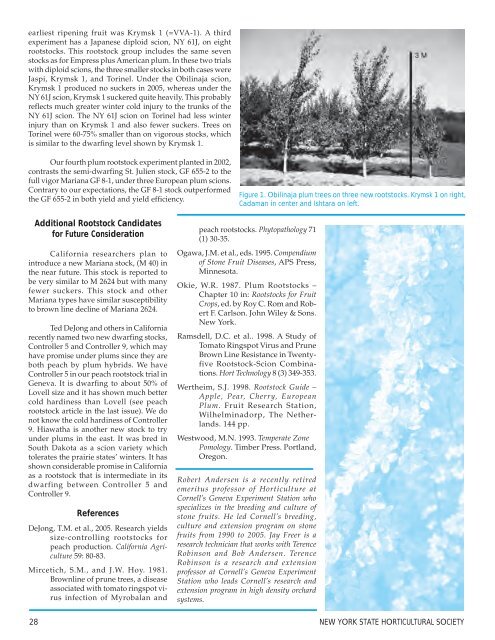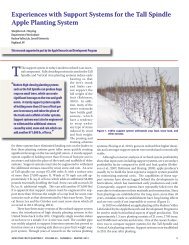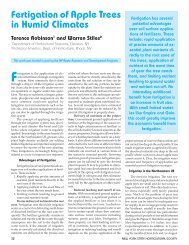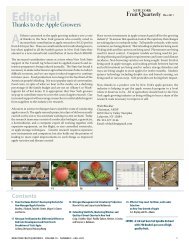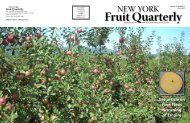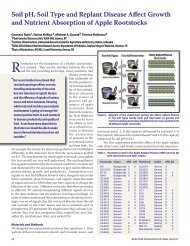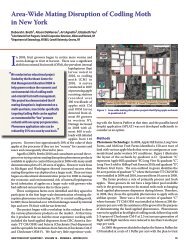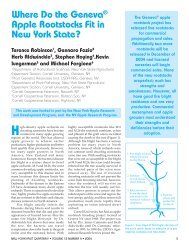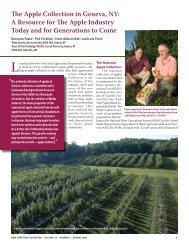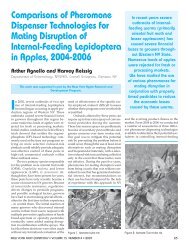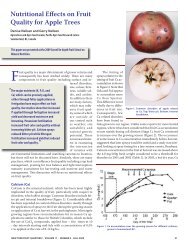plum rootstock trials in Geneva - New York State Horticultural Society
plum rootstock trials in Geneva - New York State Horticultural Society
plum rootstock trials in Geneva - New York State Horticultural Society
Create successful ePaper yourself
Turn your PDF publications into a flip-book with our unique Google optimized e-Paper software.
earliest ripen<strong>in</strong>g fruit was Krymsk 1 (=VVA-1). A third<br />
experiment has a Japanese diploid scion, NY 61J, on eight<br />
<strong>rootstock</strong>s. This <strong>rootstock</strong> group <strong>in</strong>cludes the same seven<br />
stocks as for Empress plus American <strong>plum</strong>. In these two <strong>trials</strong><br />
with diploid scions, the three smaller stocks <strong>in</strong> both cases were<br />
Jaspi, Krymsk 1, and Tor<strong>in</strong>el. Under the Obil<strong>in</strong>aja scion,<br />
Krymsk 1 produced no suckers <strong>in</strong> 2005, whereas under the<br />
NY 61J scion, Krymsk 1 suckered quite heavily. This probably<br />
reflects much greater w<strong>in</strong>ter cold <strong>in</strong>jury to the trunks of the<br />
NY 61J scion. The NY 61J scion on Tor<strong>in</strong>el had less w<strong>in</strong>ter<br />
<strong>in</strong>jury than on Krymsk 1 and also fewer suckers. Trees on<br />
Tor<strong>in</strong>el were 60-75% smaller than on vigorous stocks, which<br />
is similar to the dwarf<strong>in</strong>g level shown by Krymsk 1.<br />
Our fourth <strong>plum</strong> <strong>rootstock</strong> experiment planted <strong>in</strong> 2002,<br />
contrasts the semi-dwarf<strong>in</strong>g St. Julien stock, GF 655-2 to the<br />
full vigor Mariana GF 8-1, under three European <strong>plum</strong> scions.<br />
Contrary to our expectations, the GF 8-1 stock outperformed<br />
the GF 655-2 <strong>in</strong> both yield and yield efficiency.<br />
Figure 1. Obil<strong>in</strong>aja <strong>plum</strong> trees on three new <strong>rootstock</strong>s. Krymsk 1 on right,<br />
Cadaman <strong>in</strong> center and Ishtara on left.<br />
Additional Rootstock Candidates<br />
for Future Consideration<br />
California researchers plan to<br />
<strong>in</strong>troduce a new Mariana stock, (M 40) <strong>in</strong><br />
the near future. This stock is reported to<br />
be very similar to M 2624 but with many<br />
fewer suckers. This stock and other<br />
Mariana types have similar susceptibility<br />
to brown l<strong>in</strong>e decl<strong>in</strong>e of Mariana 2624.<br />
Ted DeJong and others <strong>in</strong> California<br />
recently named two new dwarf<strong>in</strong>g stocks,<br />
Controller 5 and Controller 9, which may<br />
have promise under <strong>plum</strong>s s<strong>in</strong>ce they are<br />
both peach by <strong>plum</strong> hybrids. We have<br />
Controller 5 <strong>in</strong> our peach <strong>rootstock</strong> trial <strong>in</strong><br />
<strong>Geneva</strong>. It is dwarf<strong>in</strong>g to about 50% of<br />
Lovell size and it has shown much better<br />
cold hard<strong>in</strong>ess than Lovell (see peach<br />
<strong>rootstock</strong> article <strong>in</strong> the last issue). We do<br />
not know the cold hard<strong>in</strong>ess of Controller<br />
9. Hiawatha is another new stock to try<br />
under <strong>plum</strong>s <strong>in</strong> the east. It was bred <strong>in</strong><br />
South Dakota as a scion variety which<br />
tolerates the prairie states’ w<strong>in</strong>ters. It has<br />
shown considerable promise <strong>in</strong> California<br />
as a <strong>rootstock</strong> that is <strong>in</strong>termediate <strong>in</strong> its<br />
dwarf<strong>in</strong>g between Controller 5 and<br />
Controller 9.<br />
References<br />
DeJong, T.M. et al., 2005. Research yields<br />
size-controll<strong>in</strong>g <strong>rootstock</strong>s for<br />
peach production. California Agriculture<br />
59: 80-83.<br />
Mircetich, S.M., and J.W. Hoy. 1981.<br />
Brownl<strong>in</strong>e of prune trees, a disease<br />
associated with tomato r<strong>in</strong>gspot virus<br />
<strong>in</strong>fection of Myrobalan and<br />
peach <strong>rootstock</strong>s. Phytopathology 71<br />
(1) 30-35.<br />
Ogawa, J.M. et al., eds. 1995. Compendium<br />
of Stone Fruit Diseases, APS Press,<br />
M<strong>in</strong>nesota.<br />
Okie, W.R. 1987. Plum Rootstocks –<br />
Chapter 10 <strong>in</strong>: Rootstocks for Fruit<br />
Crops, ed. by Roy C. Rom and Robert<br />
F. Carlson. John Wiley & Sons.<br />
<strong>New</strong> <strong>York</strong>.<br />
Ramsdell, D.C. et al.. 1998. A Study of<br />
Tomato R<strong>in</strong>gspot Virus and Prune<br />
Brown L<strong>in</strong>e Resistance <strong>in</strong> Twentyfive<br />
Rootstock-Scion Comb<strong>in</strong>ations.<br />
Hort Technology 8 (3) 349-353.<br />
Wertheim, S.J. 1998. Rootstock Guide –<br />
Apple, Pear, Cherry, European<br />
Plum. Fruit Research Station,<br />
Wilhelm<strong>in</strong>adorp, The Netherlands.<br />
144 pp.<br />
Westwood, M.N. 1993. Temperate Zone<br />
Pomology. Timber Press. Portland,<br />
Oregon.<br />
Robert Andersen is a recently retired<br />
emeritus professor of Horticulture at<br />
Cornell’s <strong>Geneva</strong> Experiment Station who<br />
specializes <strong>in</strong> the breed<strong>in</strong>g and culture of<br />
stone fruits. He led Cornell’s breed<strong>in</strong>g,<br />
culture and extension program on stone<br />
fruits from 1990 to 2005. Jay Freer is a<br />
research technician that works with Terence<br />
Rob<strong>in</strong>son and Bob Andersen. Terence<br />
Rob<strong>in</strong>son is a research and extension<br />
professor at Cornell’s <strong>Geneva</strong> Experiment<br />
Station who leads Cornell’s research and<br />
extension program <strong>in</strong> high density orchard<br />
systems.<br />
28 NEW YORK STATE HORTICULTURAL SOCIETY


